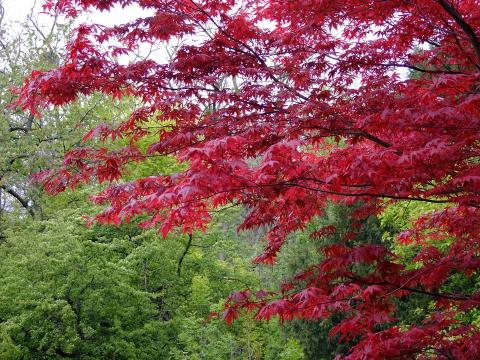How should I plant and care for a Japanese maple?

A Japanese maple (Acer palmatum) is one of the statelier plants that can be used in the garden. There is incredible variation between cultivated varieties, making it difficult to describe a typical Japanese maple. They can be grown as single-stemmed small trees or large multi-stemmed shrubs, ranging in size from six to 25 feet tall, meaning a Japanese maple can fit into a variety of landscapes. The leaves range from dark green to red or reddish-purple and can have anywhere from five to nine deeply cut lobes. Fall color is very vibrant and layered branches give Japanese maples an interesting look in the winter months.
Where to Plant a Japanese Maple
Since Japanese maples are both slow-growing and expensive to purchase, it is important to consider where they will be planted and how they will be cared for. Although they are native to Japan, China, Taiwan and Korea, Japanese maples can perform well in Zones 5 and 6 if they are planted in the right location. It is not unusual for plants to experience some dieback after especially tough winters. Prevent potential hardiness issues by planting in protected locations, safe from harsh winter winds, and avoid low-lying areas. Japanese maples tend to leaf-out early in the season and are sensitive to late spring frosts.
Japanese maples grow best when planted in well-drained, acidic soil that is high in organic matter. While they can be grown in poor soil, their growth rate is much slower and trees are more likely to experience stress. Ideally, they should be placed in a spot with dappled shade. Japanese maple foliage is prone to leaf scorch in hot and dry locations in full sun. Scorched leaves develop brown margins and often drop from the tree by mid to late summer. Planting in full sun is only an option if the soil can be kept evenly moist throughout the heat of summer. Mulching can help with this by keeping the roots cool and conserving soil moisture. Planting in the shade is often preferable, though purple-leaved varieties can develop a greenish tinge that, while still lovely, takes away from the desired characteristic of the plant.
How to Prune a Japanese Maple
Once established, Japanese maples can be considered a low-maintenance plant. They may require some structural pruning when they are young to improve their look and health, but should not warrant much additional trimming. Aim to keep branches in layers that don’t touch or rub against one another, and remove any that grow inward or are too vertical. Japanese maples are prone to dripping lots of sap when pruned in the late winter or early spring, so wait to prune until summer when the spring growth flush has ceased.
Fertilizing a Japanese Maple
Don’t bother fertilizing a newly planted Japanese maple, as it is unlikely that the roots will have the ability to take up nutrients. If necessary, established plants can be fertilized in the spring before the leaves emerge. Japanese maples don’t need much in the way of added fertilizer, particularly if the soil is full of organic matter, so only apply it if the plant seems to be growing too slowly or if a soil test indicates a deficiency. Slow release fertilizers are the best choice because they break down gradually over the course of the growing season and supply a continuous source of nutrients as the plant needs them. These types of fertilizer will have a high percentage of “water insoluble nitrogen” listed on the label.
Healthy Japanese maples have very few insect or disease issues and make a great addition to almost any garden. They do have the potential to produce viable seed and the odd seedling occasionally, but are not considered an invasive pant in New Hampshire. Observant gardeners can weed out unwanted seedlings if they emerge. As long as you pay attention to where they are planted and how they are cared for, they can provide decades of enjoyment.
Got questions? The Ask UNH Extension Infoline offers practical help finding answers for your home, yard, and garden questions. Call toll free at 1-877-398-4769, Monday to Friday, 9 a.m. to 2 p.m., or e-mail us at answers@unh.edu.
Related Resource(s)
Do you love learning about stuff like this?
SUBSCRIBE TO Granite State Gardening newsletter
Got questions? The UNH Extension Yard and Garden Infoline offers practical help finding answers for your yard and garden questions.
Call toll free at 1-877-398-4769, Monday to Friday, 9 a.m. to 2 p.m., or fill out webform.
